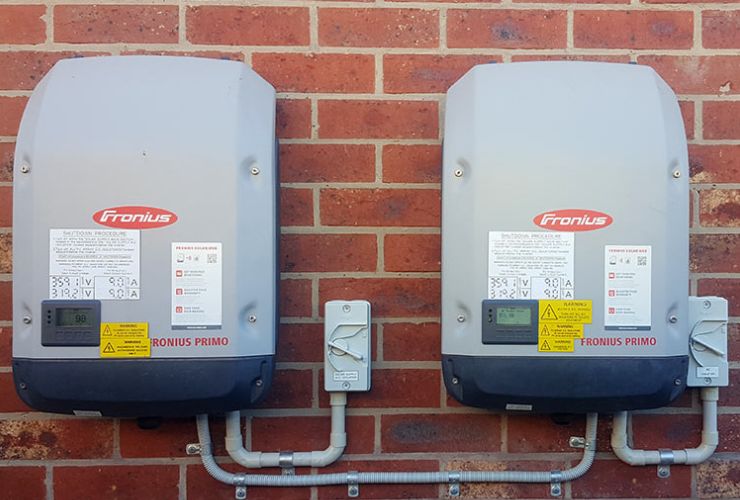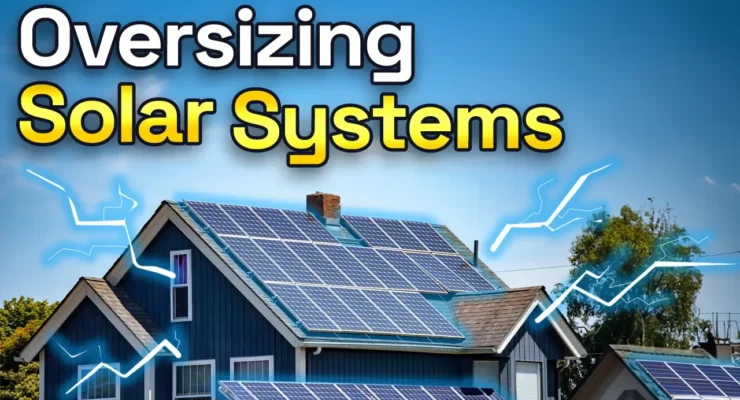Fast read
Oversizing a solar panel array can be beneficial. In the real world, a solar panel may not always produce its full power. So, an 8 kW solar panel system can work well with a 6 kW inverter.
Australia's solar rebate scheme promotes installing larger arrays, and a slightly oversized system can be cheaper per kW. Oversized arrays can generate more energy, especially during off-peak hours, compensating for energy "clipping" and offering a 28% increase in yield for only a 10% increase in installation cost.
Net metering, aesthetics, future-proofing, and inverter efficiency are factors to consider before oversizing. Professional consultation is advised for a tailored solution.
Oversizing solar systems – does it make sense?
A solar system is a group of solar panels installed together to generate electricity from the sun. The size of the array is determined by the number of panels installed and the overall capacity of the panels together. So, for example, 20 x 400 Watt panels mean you have an 8 kW array or, say, an 8 kW solar power system.
Usually, many people think that if I have 8 kW of panels, I also need an 8 kW inverter, but this is not the case. In this case, a 6 kW inverter is actually allowed under the Australian solar PV design rules. Will my solar inverter not overheat or even “explode” if I overload it with 2 kW of extra panel capacity?
Can oversizing your solar system damage the inverter?
Let me explain why this seemingly nonsensical move – actually makes sense. A 400-watt panel is tested in the factory before receiving its power class rating.
The panel is exposed to 1000 Watts of light per square meter during the test. This exposure results in a total output power of 400 watts for the panel.
But in literally all parts of Australia, the sun never reaches an irradiation of 1000 Watts per square meter. 700 to 850 Watts is the norm on many sunny days. This means a 400-watt panel rarely generates 400 Watts in our sunlight conditions.
In Europe, such as Germany or Poland, it’s even worse, where a 400-watt panel might only generate 200 Watts on a sunny summer’s day.
Higher temperatures over 25 degrees also reduce energy production
When manufactured, PV systems are tested in Standard Test Conditions (STC). These conditions are insolation of 1000W/m2, air mass of 1.5 and 25 degrees. But the issue is, in the real world, how likely is your system to be in these exact conditions?
As these temperatures increase over 25 degrees, the array will decrease power. This is common in Australia, especially concerning temperature. For this reason, having a more extensive array will counteract this decrease.
So if we translate this knowledge to an 8 kW system, it means the 20 panels will generate on a sunny day only about 300 watts – therefore, 300 W x 20 = 6ooo watts. So as you can see, a 6kW inverter will suit 8 kW of panels. It has safeguards in case over 6000 watts are produced and sent to a 6 kW solar inverter.
The solar rebate encourages oversizing
The solar rebate is linked to the panels in Australia, meaning the more panels one installs, the more rebate one gets. So often, the installer and homeowners aim to get the highest rebate, meaning they seek to fit as many panels as possible. This is because the rebate, in many cases, pays a considerable part towards the cost of the panels.
While there will initially be additional costs associated with oversizing your solar system because of a little more labour (remember the panels are to a great extent paid for via the rebate), a 6 kW inverter with 6 kW of panels will produce less solar than a 6 kW inverter with 8 kW of panels attachedç. An 8 kW panel system with a 6 kW inverter and an 8 kW panel system with an 8 kW inverter will produce remarkably similar output.
If you make your solar system bigger, you can get a cheaper price per kW. For example, a 6 kW solar inverter is usually cheaper than an 8 kW inverter.
According to Sunny Design, oversizing your solar system by 5kW can have a return of increasing the energy yield by about 28% for only an additional installation cost of 10%.

Maximise daytime energy
Depending on different electricity consumption patterns, having early morning daytime energy may be your priority. If this is the case, oversizing your solar system is smart. Increasing the size of your system will allow the inverter to reach its maximum power output earlier in the day. This will help it maintain that level of power until later in the afternoon.
This is especially great for commercial solar systems, as offices and firms would use almost all their electricity throughout the day and then fall off in the late afternoon or at night.
Net metering
If your energy company offers net metering, oversizing your solar system can be a financially smart move. Net metering allows you to sell excess electricity back to the energy retailer. The more you sell back, the more it offsets the installation cost.

A better match
Oversizing your solar system allows the rated AC power of your solar inverter to better match the DC energy output of your solar system. This means there are more options for inverters to buy, including ones with lower AC ratings. This lower rating makes the inverter cheaper. This makes the initial purchase price lower, and most likely all other inverter-related costs such as maintenance as well.
Factors to consider before oversizing your solar system
Oversizing your solar system can have some benefits. Also, a few other factors should be considered before deciding to do so.
Cost
One crucial factor to consider is the cost of oversizing your solar system. Oversizing your solar system may increase the upfront cost of the installation. It may also increase the maintenance and repair costs over the system’s lifetime, as now you have more panels to look after.
Space
Also important to consider space availability for solar panel installation. If you have limited space, consider installing a smaller panel array to use the available space efficiently.
Aesthetics
The aesthetics of the installation should also be considered. Oversizing your solar system may make the installation more visible. This can be a positive or negative factor, depending on the homeowner’s preferences and the property’s design.
Future-proofing your home
A large solar system is beneficial for future electric car or battery storage additions. This gives you greater freedom and guarantees that you can meet rising energy demands without changing your system.
Inverters efficiency
Modern solar inverters are built to withstand a certain amount of oversizing without breaking or performing poorly. They can control the input power up to a point known as “clipping.” At the same time, some energy is “clipped” or lost during high production. The increased output during off-peak hours typically more than makes up for this loss.

Determining the maximum panel capacity for your inverter
The maximum panel capacity that a solar inverter can handle is determined by its maximum power point tracking (MPPT) rating. The MPPT rating is the maximum power the inverter can handle from the solar panels and is expressed in watts. To determine the maximum panel capacity for your inverter, you will need to know the MPPT rating of your inverter and the wattage of the solar panels you are considering.
The Clean Energy Council generally allows 1/3 bigger panel capacity, compared to inverter capacity – as the golden solar panel system design rule. So a 5 kW inverter can get 6.6 kW of panels, and a 9 kW inverter can have 12 kW of panels attached.
In summary
In summary, oversizing your solar system is fine. Doing so can save you money in the long run, as it will increase the efficiency of your solar inverter.
Overall, the decision to oversize your solar system depends on your specific circumstances and energy needs. Consult a solar installation professional to determine the suitable size panel array for your needs. Think about cost, space, and looks when deciding if oversizing your solar system is right for you.



